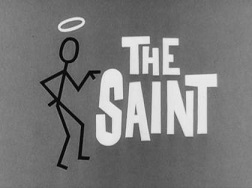
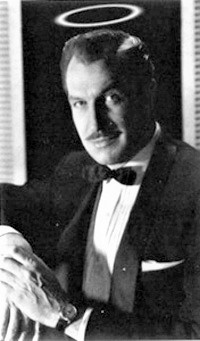 The Saint aired “Nineteen Santa Clauses” on December 25, 1949. Crime and mystery novelist Leslie Charteris’ (1907-1993) famous detective Simon Templar was dubbed The Saint by the underworld, though he was hardly what the monicker implied. The story goes that he came by the name because of his initials, S. T.. The Saint, as a radio show (there were movies, tv shows, novels, and even comic books), ran from 1947-1951, with almost all episodes featuring the incomparable Vincent Price.
The Saint aired “Nineteen Santa Clauses” on December 25, 1949. Crime and mystery novelist Leslie Charteris’ (1907-1993) famous detective Simon Templar was dubbed The Saint by the underworld, though he was hardly what the monicker implied. The story goes that he came by the name because of his initials, S. T.. The Saint, as a radio show (there were movies, tv shows, novels, and even comic books), ran from 1947-1951, with almost all episodes featuring the incomparable Vincent Price.
The first Saint novel was published in 1928 when Charteris was just shy of his 21st birthday and was titled Meet the Tiger. In later years Charteris practically disowned the novel, remarking that it was so poorly written he wondered how it ever got published. Instead, he preferred to count 1930’s second Saint novel Enter the Saint as the first true Saint novel. Be that as it may, he would write Simon Templar adventures (novels, short stories, and novellas) off and on for the next 33 years, the final Saint book written solely by himself being a collection of  stories in 1963 titled The Saint in the Sun. Thereafter, all of the Saint titles would be ghost-written but credited to Charteris, who remained in an editorial capacity, reading the manuscripts and editng where necessary. Of interest to science fiction readers is that the first of the ghost-written Saint novels was written by none other than Harry Harrison (1925-2012, SFWA Grand Master 2009, photo at left), and was 1964’s Vendetta for the Saint. Harrison, also an illustrator early in his career (the legendary Wally Wood would ink Harrison’s pencils for several SF comics, among them Weird Fantasy and Weird Science), also wrote the syndicated The Saint comic strip.
stories in 1963 titled The Saint in the Sun. Thereafter, all of the Saint titles would be ghost-written but credited to Charteris, who remained in an editorial capacity, reading the manuscripts and editng where necessary. Of interest to science fiction readers is that the first of the ghost-written Saint novels was written by none other than Harry Harrison (1925-2012, SFWA Grand Master 2009, photo at left), and was 1964’s Vendetta for the Saint. Harrison, also an illustrator early in his career (the legendary Wally Wood would ink Harrison’s pencils for several SF comics, among them Weird Fantasy and Weird Science), also wrote the syndicated The Saint comic strip.
Simon Templar falls into the camp of the “soft-boiled” detective, in line with such as Nero Wolfe, Sherlock Holmes, and Dashiell Hammett’s Nick Charles (who prefer solving crimes with their wits rather than their fists), as opposed to the “hard-boiled” branch of the detective tree and the likes of Sam Spade, Phillip Marlowe, and Boston Blackie. The iconic stick figure with halo representing the Saint was first introduced in the early stories as a calling card Templar would leave so that his enemies would know who was responsible for their downfall. The titlecard/logo at top left was used in the 1960’s The Saint tv series starring future James Bond star Roger Moore. The series originated in the UK and ran from 1962-69, but was picked up by NBC in America and ran as a summer replacement in 1966.
On American radio, however, Vincent Price was the undisputed, one and only Simon Templar, the Saint. His velvety voice and witty banter engendered the proto-typical suave, bon vivant hero/detective, though in a number of episodes the sexual innuendos written for not only his lines, but those of other characters, were a bit too obvious for the perceived audience in the late 1940s, though The Saint‘s legion of fans didn’t seem to care. “The Nineteen Santa Clauses” aired on Christmas day 1949, and the opening scene has Simon Templar getting dressed as Santas Claus for a holiday function, when he is surprised by a young woman who, after bursting into his room, points a gun at him in a case of mistaken identity–which leads directly to the adventure at hand. What struck me as humorous was the seemingly innocent (we are led to believe) young woman’s attempt at tough banter, the harsh threats and phrases she barks out in sharp contrast to her feminine pitched voice, written purposefully with the humor in mind and to which the Saint quickly responds in his usual non-plussed manner. It’s a fun episode, if stolen jewels and murder are what you look for in your Christmas stocking. But be warned, the Saint is definitely not Santa Claus, nor is Santa Claus the Saint.
Play Time: 29:08
{Inspired by this episode of The Saint, several of the neighborhood gang opted for mystery and detective pulps at the local newsstand, while another remained loyal to his love of the fantastic and went with Weird Tales. WT (1923-54) was sailing along with its six bi-monthly issues in 1949, as were Famous Detective (1938-51) and Thrilling Detective (1931-53).
[Left: Famous Detective, Nov. 1949 – Center: Thrilling Detective, Dec. 1949 – Right: Weird Tales, Nov, 1949]
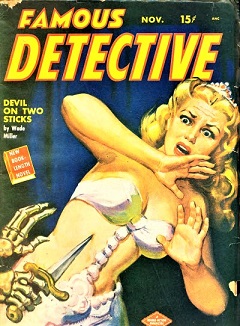
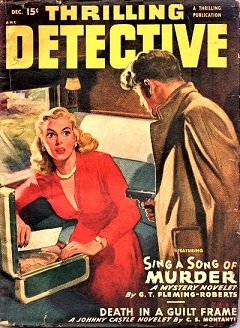
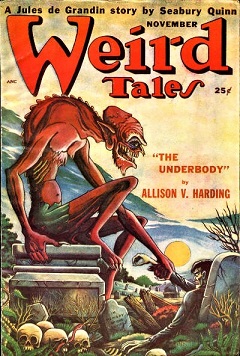
To view the entire list of weekly Old Time Radio episodes at Tangent Online, click here.